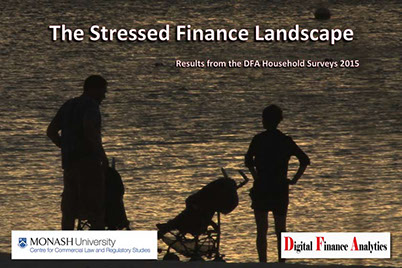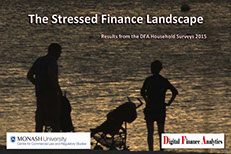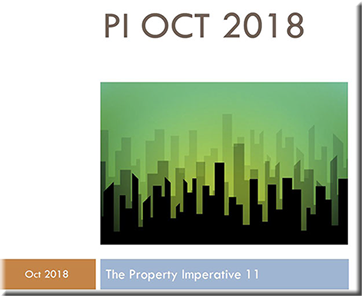
Copies of selected reports are available on request.
The Stressed Household Finance Landscape.
Results from our 2015 Household Surveys, focussing on financially stressed households, their financial footprint and needs; including use of payday loans and channel preferences
We have completed detailed analysis of households and their use of small amount credit contracts, a.k.a. payday lending. The analysis, derived from our long-standing household surveys, was undertaken in conjunction with Monash University Centre for Commercial Law and Regulatory Studies (CLARS) and commissioned by Consumer Action Law Centre, Good Shepherd Microfinance, and Financial Rights Legal Centre.
We review detailed data from the 2005, 2010 and 2015 surveys as a means to dissect and analyse the longitudinal trends. The data results are averaged across Australia to provide a comprehensive national picture. We segment Australian households in order to provide layered evidence on the financial behaviour of Australians, with a particular focus on the role and impact of payday lending.

The 2017 Small Business Survey.
Results from our 2017 Small and Medium Business Survey focussing on their needs, banking and channel preferences
From the introduction:
There are around 2.2 million small and medium businesses (SME) operating in Australia, and nearly 5 million Australian households rely on income from them directly or indirectly. So a healthy SME sector is essential for the future growth of the country.
However, the latest edition of the Digital Finance Analytics Small and Medium Business report reveals that more than half of small business owners are not getting the financial assistance they require from lenders in Australia to grow their businesses.
Most SME’s are now digitally literate, yet the range of products and services offered to them via online channels remains below their expectations.
More SME’s are willing to embrace non-traditional lenders, via Fintech, thanks to greater penetration of digital devices, and more familiarity with these new players. In addition, many firms said they would consider switching banks, but in practice they do not.

The Property Imperative 11.
Results from our 2018 Household Survey focussing on property ownership trends by customer segment.
This Property Imperative Report is a distillation of our research in the finance and property market, using data from our household surveys and other public data. We provide weekly updates via our blog – the Property Imperative Weekly, and our YouTube Channel, but twice a year publish this report. This is volume 11.
The past six months has seen a significant shift in momentum as home prices have moved lower across many of the main centres, auction clearance rates have eased, and more property stock is added to the market, thanks to more new builds and as more owners try (or are forced) to sell.
Many of the “experts” have changed their tune and are expecting to see further falls in home prices ahead, although the extent and speed of these falls remains uncertain. Meantime more households are in financial stress, as incomes remain constrained, costs of living rise, and returns from investments look shaky. No surprise to see mortgage delinquencies are rising, though they are still in an absolute sense very low.
At its heart, home price growth is fundamentally linked to credit availability and thanks to belated tightening from APRA, the fallout from the Royal Commission into Financial Services Misconduct, and the Productivity Commission and ACCC work, lending standards continue to tighten.
Whilst some still spruik future growth thanks to migration, government intervention, or first time buyer appetite, these factors pale into insignificance against the global backcloth of rising interest rates, slowing global growth and broader political and economic uncertainty.
The Quiet Revolution.
Results from our Household Survey focussing on banking channel preferences
From the introduction:
This report contains the latest results from our household surveys with a focus on their use of banking channels, preferred devices and social media trends.
Our research shows that consumers have largely migrated into the digital world and have a strong expectation that existing banking services will be delivered via mobile devices and new enhanced services will be extended to them. Even “Digital Luddites”, the least willing to migrate are nevertheless finally moving into the digital domain. Now the gap between expectation and reality is larger than ever.
Looking across the transaction life cycle, from search, apply, transact and service; universally the desire by households to engage digitally is now so compelling that banks have no choice but to respond more completely.
We also identified a number of compelling new services which consumers indicated they were expecting to see, and players need to develop plans to move into these next generation banking offerings. Many centre around bots, smart agents and “Siri-Like” capabilities.
We are now at a critical inflection point in the development of banking as digital now takes the lead. Players must move from omni-channel towards digital first strategies, where the deployment of existing services via mobile is just the first stage in the development of new services, designed from the customers point of view and offering real value added capabilities. These must be delivered via mobile devices, and leverage the capabilities of social media, big data and advanced analytics.
This is certainly not a cost reduction exercise, although the reduction in branch footprint, which we already see as 10% of outlets have closed in the past 2 years, does offer the opportunity to reduce the running costs of the physical infrastructure. Significant investment will need to be made in new core capabilities, as well as the reengineering of existing back-end systems and processes. At the same time banks must deal with their “stranded costs”.
DFA authors reports for clients, and the broader industry, using a number of proprietary industry models. Recent coverage includes:
Consumers Emerging Device Preferences
Profile of a Digital Native
Social Media for banking
Mortgage Stress
Mortgage Industry Dynamics
Superannuation trends
Payday lending
Heath Insurance affordability
Small and Medium Business Sector trends
Segmenting the Australian Consumer market - winners and losers
Whilst these reports are not generally available to a wider audience, if you are after something specific, then use the "Contact" button above to make an enquiry and we will try to assist.
All information contained in this site remains the intellectual property of Digital Finance Analytics and it may not be reproduced or mirrored without specific agreement. We do not accept any liabilities for errors or omissions and will not accept any claims for consequential loss whatsoever; The site is "as is" and no guarantee is given as to its ongoing availability. Site visits are subject to these terms.







